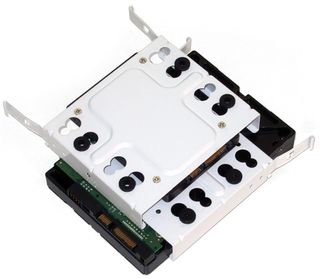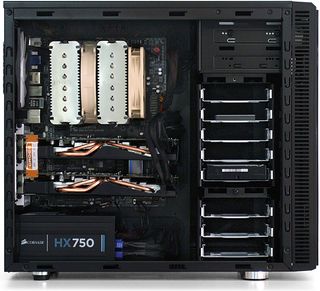System Builder Marathon, Q1 2013: $1,600 Alternative PC
Starting Over, This Time With Success

These are the good old days…
Twelve years have passed since the last time I was forced to chase down such a series of catastrophic events, where a board damaged a processor that in turn damaged every board it touched, which in turn would damage every processor it touched. Back then, I had to pay for that troubleshooting myself. This time, I only had to explain why my two-week paycheck hadn't yielded any content.
Switching to a motherboard that held-up under the load of Noctua’s NH-D14 installation kit, and a memory set that wouldn’t damage the apparently-fragile E1-stepping Core i5-3570K’s memory controller, I moved on to re-build the system.

Fractal Design’s trays support 2.5” drives by direct mounting, and 3.5” drives through grommets and included shoulder screws. The shoulder screws prevent grommet crushing, and the grommets prevent the transmission of vibration from mechanical drives to the drive cage.

We probably don’t need to re-shoot the CPU cooler installation, since the same method was used a second time on the Gigabyte motherboard. The big difference is that Gigabyte supplies only one CPU fan header, so we had to include the NH-D14’s fan power splitter in our installation.

Finally, a working system that doesn’t slowly die after a couple of days!
Current page: Starting Over, This Time With Success
Prev Page Ten Days, Ten Solutions? Next Page OverclockingStay on the Cutting Edge
Join the experts who read Tom's Hardware for the inside track on enthusiast PC tech news — and have for over 25 years. We'll send breaking news and in-depth reviews of CPUs, GPUs, AI, maker hardware and more straight to your inbox.
-
Crashman Azn CrackerAren't the 7870 myst only $240 a piece?See This?Reply
Article TextThe prices in that table were what we paid when the parts were ordered, and a lot of them changed over the last six weeks. For example, the PowerColor card is $20 less, per board. Other prices are up. All told, then, the total cost of buying our machine and replicating the build is within $20 of our original invoice. -
mikenygmail Please call the graphics cards 7870 LE from the start, like this:Reply
"Video Cards: 2 x 7870 LE - PowerColor PCS+ AX7870 Myst Edition"
After all, it is much more than a standard 7870.
I had no idea it was the LE until I got to the third page. -
Crashman mikenygmailPlease call the graphics cards 7870 LE from the start, like this:"Video Cards: 2 x 7870 LE - PowerColor PCS+ AX7870 Myst Edition"After all, it is much more than a standard 7870.I had no idea it was the LE until I got to the third page.In AMD/ATI model lingo, LE stands for a cut-down part. So a Tahiti-LE wouldn't be a 7870 LE, it would be a 7950 LE. The fact that it carries the 7870 model number is unfortunate, but the article attempts to make it clear that this is indeed a Tahiti-LEReply
-
Crashman StickmansamWhy not the 7870XT like Sapphire calls it?That's fine, please tell AMD to do the re-brand!Reply -
pyro226 "a board damaged a processor that in turn damaged every board it touched, which in turn would damage every processor it touched" and ram damaging a CPU?Reply
I think I'm a bit afraid to build computers now. If either of those situations would have happened to my $600 build, I would have cried and given up... -
Fulgurant pyro226"a board damaged a processor that in turn damaged every board it touched, which in turn would damage every processor it touched" and ram damaging a CPU?I think I'm a bit afraid to build computers now. If either of those situations would have happened to my $600 build, I would have cried and given up...Reply
That sort of thing happens once in a blue moon. Don't let it bother you.
I guess Tom's tale of woe summarizes why Intel recommends against higher than 1.575 volts on the memory controller of Ivy/Sandy:
http://www.intel.com/support/processors/sb/CS-029913.htm#4
IntelWhat are the Intel® Core™ i7 desktop processor DDR3 memory voltage limitations?Intel® recommends using memory that adheres to the Jedec memory specification for DDR3 memory which is 1.5 volts, plus or minus 5%. Anything more than this voltage can damage the processor or significantly reduce the processor life span.
In any case, the performance benefits of overclocking memory on a Sandy/Ivy platform seem so miniscule that it's scarcely even worth considering. Buy memory capable of an appropriate speed @ 1.5V, and leave it be.
(I know Tom mentions Intel's position on memory voltage on the last page of the article, but I wanted to re-emphasize it because I've seen literally hundreds of people dismiss Intel's statement on various hardware forums. When sites like Tom's Hardware push limits, even for questionable performance gains, we all benefit -- but when someone who's on a budget and might not know any better pushes limits on his own, hard-earned hardware, the results might be tragic. Tom's experiments with this stuff so we don't have to.) -
Crashman pyro226"a board damaged a processor that in turn damaged every board it touched, which in turn would damage every processor it touched" and ram damaging a CPU?I think I'm a bit afraid to build computers now. If either of those situations would have happened to my $600 build, I would have cried and given up...I told Chris the system was cursed, but he refused to let the project go after the seventh day. Three more days rescued the content, if not the hardware...Reply
FulgurantThat sort of thing happens once in a blue moon. Don't let it bother you.Once every 12 years is twice in 13 years too often...

